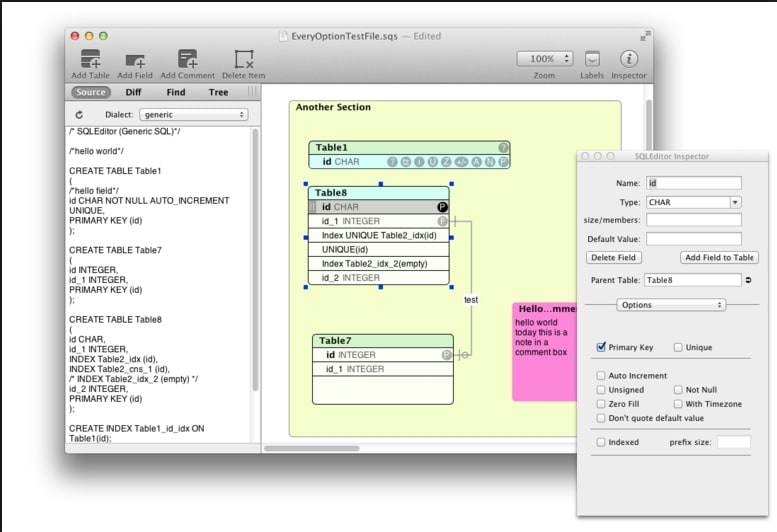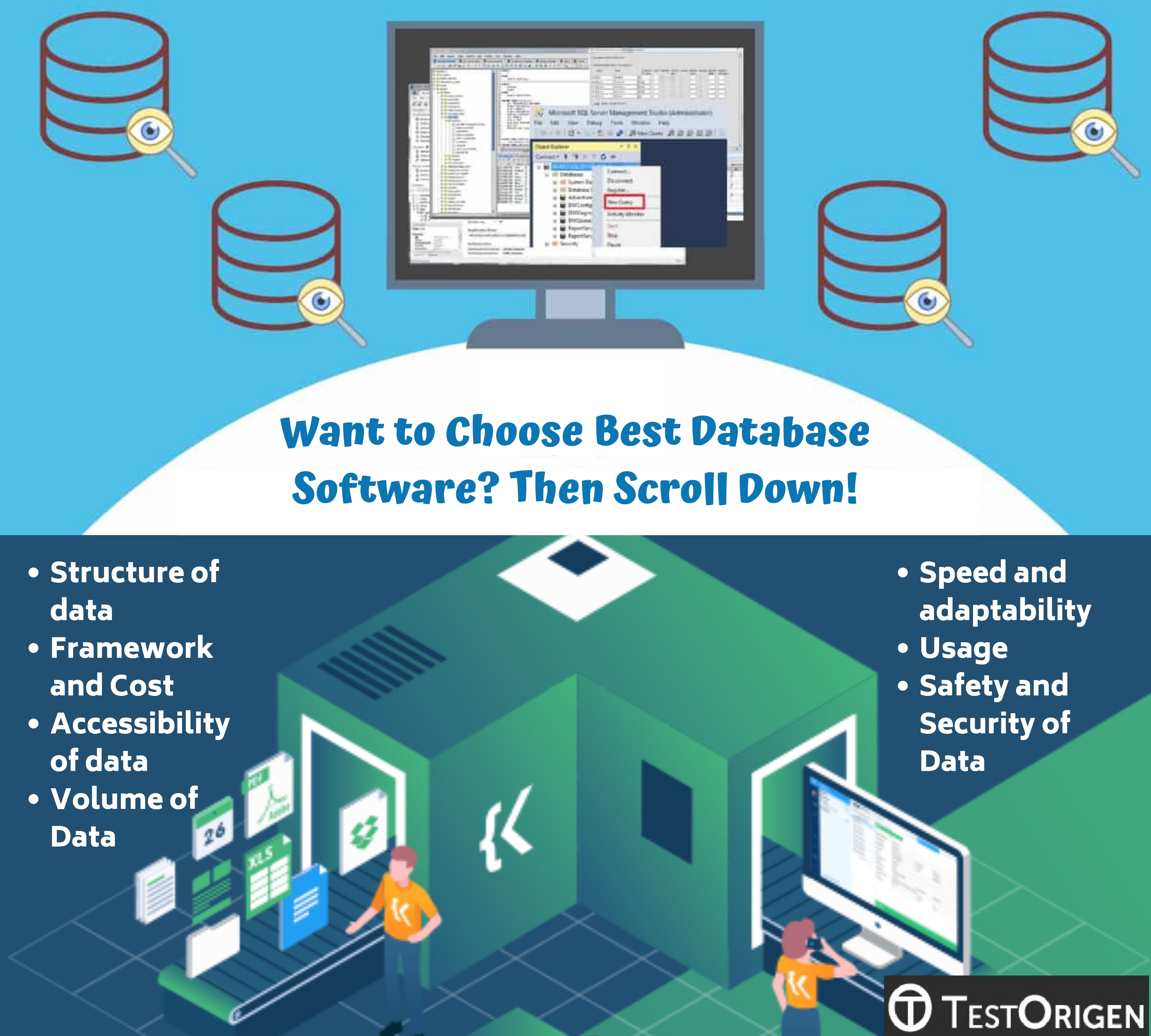A database schema is the blueprints of your database, it represents the description of a database structure, data types, and the constraints on the database. And designing database schemas is one of the very first and important steps to start developing any software/website.
- Free Database Software
- Free Database Software Online
- Free Database Software For Mac
- Free Database Software Like Access
To help you determine the right tool for you to design database schema diagrams, we've curated a list of 5 of the best free online tools to do it.
Top 5 Free Database Diagram (ERD) Design Tools
dbdiagram.io
Download student database software for free. Development Tools downloads - Student Enrollment Database Software by Sobolsoft and many more programs are available for instant and free download.
Pricing: Free with unlimited objects and diagrams
- dbdiagram.io is a quick and simple database designer to help you draw your database diagrams using their own Domain-specific language (DSL).
- They have a simple language to define, you can easily edit/copy without leaving keyboard
- They focus exclusively on drawing database relationship diagrams
- Allow you to save and share your diagrams online.
- Designed for developers, DBA, data analysts
- Their UI looks simple and neat, with pretty diagrams.
Draw.io
Best Free Database Software. Database software (DBMS) enables the organized entry, storage and indexing of data and information in structured fields, tables and columns, for access by authorized personnel to query, update, and report upon. This was all about the free database software. Out of these free software, cloud Version is available for MySQL, Oracle, MongoDB, MariaDB, and DynamoDB. MySQL and PostgreSQL come without any limitation to RAM and database. MySQL and SQL Server are easy to use. MySQL can be used for high volume websites, packaged software, and business-critical.
Pricing: Free for web-based usage, paid for Atlassian (Confluence/JIRA) apps.
- Draw.io is a free online diagram software for making flowcharts, process diagrams, etc.
- Allows different types of charts like flowcharts, org charts, UML, ER and network diagrams.
- Allows saving your diagrams to cloud storage services like GDrive, Dropbox and OneDrive, or to your own computer
- Visual interfaces not as nice as lucidchart.
Lucidchart
Pricing: Free with limited objects, $4.95-$20/month
Lucidchart is cloud-based and collaborative diagram software. Lucidchart helps your team create not only database diagram but also flowcharts, process maps, UML models, org charts,.. on any device across the platform you already use.
Free plan comes with a limit of 3 diagrams and 60 objects per diagram
Good experience and collaborative
Integrated with G Suite, Microsoft Office...
Good if you are more of a designer and want drag-and-drop interface
SQLDBM
Pricing: Free (Beta) with unlimited diagrams and objects
- SqlDBM offers you an easy, convenient way to design your database absolutely anywhere on any browser, working away without need for any extra database engine or database modelling tools or apps.
- They incorporates any needed database rules and objects such as database keys, schemas, indexes, column constraints and relationships
- Only support MySQL and MS SQL
- Support Forward Engineering and Reverse Engineering
- 100% drag and drop UI
- Support version history
QuickDBD
Pricing: free for 1 public diagram and 10 tables, plans at $14/month for unlimited tables and private diagrams.
Free Database Software
- QuickDBD helps you quickly draw a diagram using just text input.
- It quickly captures ideas, and you can draw schema diagrams using only the keyboard.
- Support exporting to SQL, PDF and Word
Jump to:
Microsoft SQL Server
MongoDB
Oracle Database
Managing your database without a database management tool can be tricky. You could end up with duplicate files stored in multiple locations, have trouble sharing data with people and other systems, and if your data isn’t well protected, you may also face security risks. These risks can involve spyware attacks, malware attacks, or SQL injections—all of which threaten your company’s data privacy.
Using a database management system will let you store, access, and share your business information easily. You’ll get more visibility into where your data is stored and who has access to it. The tool will also make it easier to backup and recover your business data.
In this article, we’ve listed the three best free database software solutions you can try. Each of these tools (arranged alphabetically) has a minimum user rating of 4.5 out of 5 on Capterra and offers the key database software features. See the full selection methodology here.
SEE FREE DATABASE MANAGEMENT TOOLS
- Free plan: Two free editions are available: SQL Server 2019 Developer and SQL Server 2019 Express. The former supports one user, is a full-featured plan, and is licensed for use as a development and test database in a non-production environment. The latter is ideal for the development of desktop, web, and small server applications.
- Paid plans: Paid editions range from $209 to $13,748 based on the licensing model and channel availability.
Microsoft SQL Server is a relational database management tool that works with software applications to store and fetch data as needed. It lets you run SQL queries across your database, manage both structured and unstructured data, and build machine learning models for advanced data analysis.
The software offers database encryption to keep your business information secure, even if it gets stolen. It also provides database compatibility certification, which helps ensure all your applications are compatible with the tool. The tool automatically downloads and installs updates, making the user experience convenient for you.

MongoDB
4.6/5
Read user reviews
- Free plan: Offers 512MB of storage space and is suitable for teams learning MongoDB or developing small applications.
- Paid plans: The tool offers two paid plans: Dedicated Clusters and Dedicated Multi-Region Clusters for $57 and $97 per month, respectively.
MongoDB is a NoSQL database tool that offers various queries and filters to help navigate your business data. Its multicloud data distribution functionality allows you to use multiple clouds simultaneously to store data. It also offers built-in apps such as BI Connecter and Compass to visualize and analyze your data and provide deeper insights.
The tool offers an interface via which you can access and share your data with other software applications. It helps provide a logical structure to your data and make optimal use of storage space by limiting duplicate items or values. It also helps optimize resource utilization, scale your storage needs, and meet your data recovery requirements.
Free Database Software Online

- Free plan: Two free editions are available: Oracle Autonomous Transaction Processing and Oracle Autonomous Data Warehouse. Each option offers up to 20GB of free storage.
- Paid plans: Paid plans start at $0.1935 per unit, measured in Oracle computing unit (OCPU) per hour.
Oracle Database is a multimodel relational database management system that supports multiple structures for organizing and storing data. Some of its key features include data warehousing, database security, application development, real-time application testing, machine learning model development, and an SQL editor.
Free Database Software For Mac
The tool’s real application clustering and portability feature allows you to scale the software per your needs, and its backup and recovery feature helps recover lost data in case of statement failure, process failure, or instance failure. It also offers performance tuning, which lets you speed up the tool’s response time when large data volumes begin to slow down the system.
How to choose the right free database tool for your business
Free Database Software Like Access
These considerations can make selecting a free database application a little easier:
- Double-check data security options. The tool will store your business data, including sensitive strategic or financial information. You wouldn’t want this data to fall into the hands of hackers or your competitors. Thus, ask the software provider what data security measures they will take to protect your data from unauthorized access.
- Ask about additional costs. Most database tools, including the ones mentioned in this article, involve extra charges for some services. These could be hosting charges, cost for additional storage space, or data migration costs. But these costs may not be explicitly mentioned on the product website or may be hidden in some obscure corner of a webpage. Therefore, check with the vendor if there’ll be any additional charges in the future.
- Check the tool’s complexity level. Database tools can be fairly complex to work with. As the tool will also be used by business departments other than your IT team, make sure everyone is comfortable with its complexity level. When choosing a product, be sure to get buy-in from all the teams that’ll be working with the tool.
- Read product reviews. Before finalizing a tool, read its user reviews on third-party websites such as ours. Reviews will help you understand the tool’s performance, features, and pros and cons in more detail. Check out this article to learn how to make the most of user reviews.
Common questions to ask when selecting a free database software tool
Here are a few questions you can ask the software provider to learn more about the key aspects of the database management app you’re planning to purchase:
- Which programming languages does the tool support? Check with the software provider if the tool supports programming languages of your choice. While most database software tools support multiple query languages, some are compatible with only a few specific ones. Thus, make sure the tool supports your preferred query language.
- Does the tool support third-party integrations? You may need to integrate the tool with your data visualization, business intelligence, data warehouse, or CRM software to carry out diverse operations on your data or to extract relevant information. So, ensure the tool you select supports integration with third-party solutions.
- What kind of support options are available? Database tools can be complex to work with, and any issue with the tool can affect the other software apps whose data is managed by the tool. So, check with the software provider about the support options they offer. See if these options are available for free or come at an additional cost. Also, make sure customer support is available during your working hours.
How we evaluated products
This article was updated on March 11, 2021. Products considered for this article had to:
- Be included in Capterra’s Top 20 Database Management Software report.
- Offer a free, stand-alone version of the software (not a trial version of the software where you must purchase a product after a limited amount of time).
- Meet our database management system market definition: Database management software, or DBMS, helps users interact with databases across the business to retrieve, edit, delete, backup, etc., data.

Software that met the market definition also needed an above-average overall user rating compared to other products in the category.
- “Best” free tools had a minimum overall rating of 4.5 out of 5 stars from reviewers on Capterra at the time of publication.